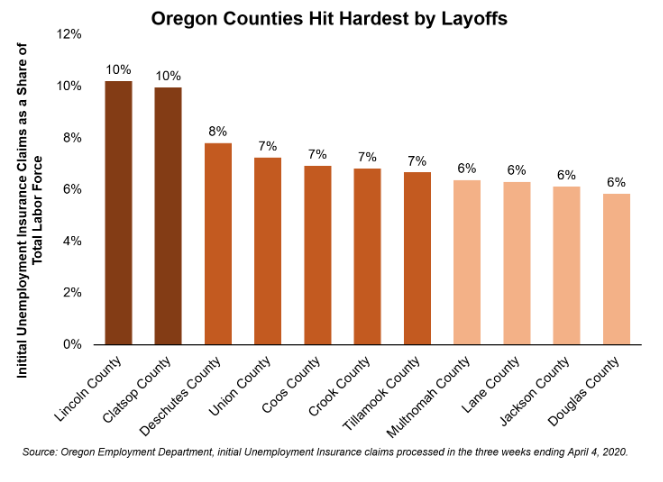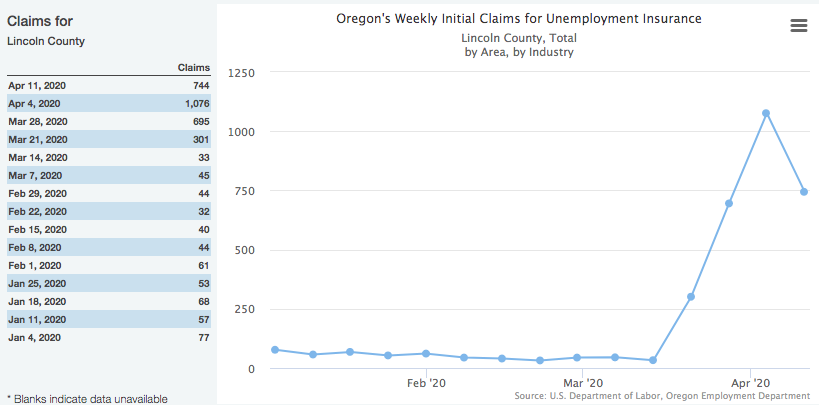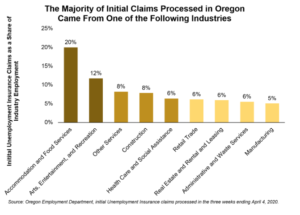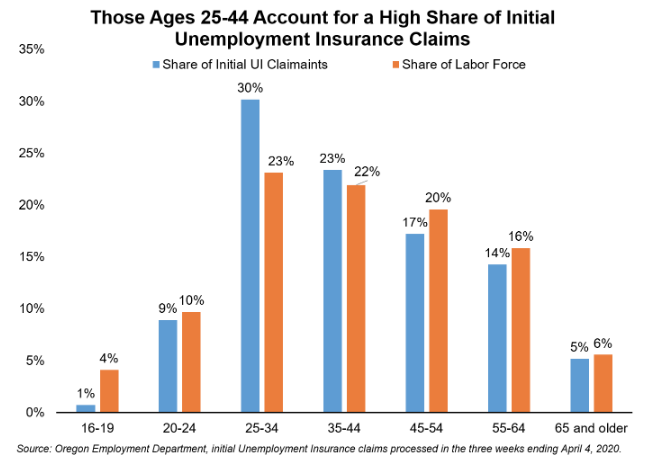
By QUINTON SMITH/YachatsNews.com
Because of its reliance on tourism, Lincoln County has been the hardest hit county in the state in the percentage of its workers suddenly losing their jobs because of the COVID-19 crisis.
The Oregon Employment Department released its weekly report Thursday on county and statewide unemployment claims. For the fourth straight week it wasn’t pretty.
Across Oregon, the agency reported 54,000 new unemployment claims for the week ending April 11, with total layoffs nearing 300,000 in the past four weeks. And those are claims from the newly unemployed who have been able to access the state’s claim system, which has been plagued by computer issues and overloaded call centers.
In Lincoln County, 744 workers filed new unemployment claims for the week ending April 11, bringing the county’s total new jobless claims to 2,816 since March 14.
Of that total, exactly half – 1,408 — were workers in the hospitality and retail business, according to the agency’s numbers for Lincoln County.
While other Oregon counties have a higher number of claims, the agency said, as a percentage of the workforce Lincoln and Clatsop counties have had 10 percent of their workers lose jobs – the highest percentage among Oregon’s 36 counties. That’s because the coastal economy is heavily dependent on tourism.

“We see that counties with large accommodation and food service sectors and tourism destinations were the hardest hit,” Damon Runberg, a regional economist for the Oregon Employment Department, wrote in an analysis of the new numbers. “The number of initial claims processed in both Lincoln and Clatsop counties on the Oregon coast represented more than 10 percent of the labor force.”
Statewide, Runberg said that the hospitality industry has accounted for 20 percent of the jobless claims.
But Runberg said a surprising number of unemployment claims have come more recently in the health care, construction and manufacturing sectors.
“These were industries that on first glance would seem more insulated from the initial COVID-19 restrictions,” he said.
Layoffs in health care, Runberg said, came from health-related businesses “not on the front lines of the coronavirus response” such as dentist offices, medical transportation, labs and surgery centers.
“Many elective procedures are being postponed until the health crisis diminishes and there is less strain on the hospital system,” he said.
In Lincoln County, there were 56 new healthcare unemployment claims last week, for a total of 205 since March 14.

Runberg said layoffs in the construction and manufacturing industry were likely due to the businesses struggling to implement social distancing requirements. In Lincoln County, which has a number of small construction and manufacturing businesses, the total jobless claims in those categories the past four weeks was 242.
In analyzing other parts of jobless claims Runberg also found:
- Education matters. Some 58 percent of those laid off had a high school diploma or less, while 22 percent had some college or a community college associate’s degree. “This is likely a reflection of the industries that have been hardest hit, such as leisure and hospitality, construction, retail, and manufacturing that have a higher concentration of workers with a high school degree or less,” Runberg wrote.
- Workers age 25 to 34 “have been particularly hard hit” and comprising 30 percent of new claims. “It could be that this age group accounts for a larger share of the jobs in industries that were particularly hard hit,” Runberg said. “It could also be that this group represents workers earlier in their career and they were more susceptible to layoffs than higher level managers or supervisors.”

The state paid out $97 million in unemployment benefits last week. However, many people have not been able to receive payments due to the agency’s lack of staff and outdated technology.
Despite quadrupling the claims-handling staff, the department answered only 801 of the 2,206 calls received Wednesday, and the average wait time was about two hours.
Communications Manager Gail Krumenauer said additional staff are still being hired. With record unemployment up through early March, the agency had a small staff handling claims. It has gone from 106 personnel then to 450 now, with a goal of 800.
“It’s hard to overstate what an incredible change this has been in almost no time for Oregonians and for the department,” she said.
Computer systems are being reprogrammed to handle the federal Pandemic Unemployment Assistance program, which will allow many self-employed, contract or gig workers to receive unemployment benefits for the first time.
But Krumenauer said it will take 4,000 of hours to reprogram computers to eliminate the one-week wait before people are eligible for benefits. Because the reprogramming will take staff away from existing work, the department is focusing first on getting the most money to the most people.
“The agency has prioritized doing what we can to get the most benefits to the most affected workers, the fastest,” she said in a department video. “We’ve already seen the total benefits paid went from $25 million in one week to about $100 million in the next. That’s real money right now in people’s pockets, so that’s been our first priority.”


